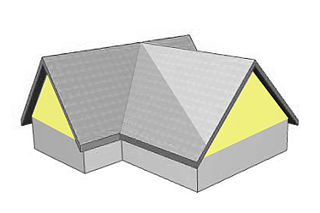
Peckforton Castle is a Victorian country house built in the style of a medieval castle. It stands in woodland at the north end of Peckforton Hills one mile (2 km) northwest of the village of Peckforton, Cheshire, England. It is recorded in the National Heritage List for England as a designated Grade I listed building. The house was built in the middle of the 19th century as a family home for John Tollemache, a wealthy Cheshire landowner, estate manager, and Member of Parliament. It was designed by Anthony Salvin in the Gothic style. During the Second World War it was used as a hostel for physically handicapped children.

Lyme Park is a large estate located south of Disley, Cheshire. The estate is managed by the National Trust and consists of a mansion house surrounded by formal gardens, in a deer park in the Peak District National Park. The house is the largest in Cheshire, and is recorded in the National Heritage List for England as a designated Grade I listed building.
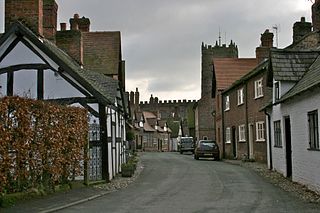
Great Budworth is a village and civil parish in Cheshire, England, four miles (6.4 km) north of Northwich off the A559 road, east of Comberbach, northwest of Higher Marston and southeast of Budworth Heath. Until 1948, Great Budworth was part of the Arley Hall estate.

Eaton Hall is the country house of the Duke of Westminster. It is set within a large estate 1 mile (2 km) south of the village of Eccleston, in Cheshire, England. The house is surrounded by formal gardens, parkland, farmland and woodland. The estate covers an area of about 10,872 acres (4,400 ha).
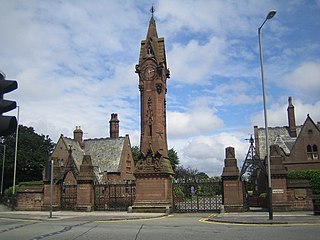
Anfield Cemetery, or the City of Liverpool Cemetery, is located in Anfield, a district of Liverpool, Merseyside, England. It lies to the northeast of Stanley Park, and is bounded by Walton Lane to the west, Priory Road to the south, a railway line to the north, and the gardens of houses on Ince Avenue to the east. The cemetery grounds are included in the National Register of Historic Parks and Gardens at Grade II*.

Norton Priory is a historic site in Norton, Runcorn, Cheshire, England, comprising the remains of an abbey complex dating from the 12th to 16th centuries, and an 18th-century country house; it is now a museum. The remains are a scheduled ancient monument and are recorded in the National Heritage List for England as a designated Grade I listed building. They are considered to be the most important monastic remains in Cheshire.
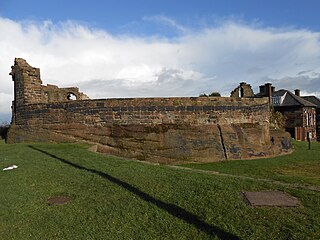
Halton Castle is a castle in the village of Halton which is part of the town of Runcorn, Cheshire, England. The castle is situated on the top of Halton Hill, a sandstone prominence overlooking the village. A motte and bailey castle was built with construction starting in 1071, the original building was replaced with the current sandstone castle in the 13th Century. Building alterations continued until at least 1609 when the structure is recorded as in disrepair. The castle is recorded in the National Heritage List for England as a designated Grade I listed building, and a scheduled ancient monument.

Runcorn is an industrial town in Halton, Cheshire, England, on the south bank of the River Mersey where it narrows at Runcorn Gap. In the town are the 61 buildings that are recorded in the National Heritage List for England as designated listed buildings in the current urban area of Runcorn, including the districts of Runcorn, Halton, Weston, Weston Point, and Norton. Two of these are classified as being in Grade I, nine in Grade II*, and fifty in Grade II.

In the early 18th century the Oulton Estate was home to the Egerton family and comprised a manor house and a formal garden surrounded by farmland in Cheshire, England. Later in the century the farmland was converted into a park. The estate is now the site of the motor racing track called Oulton Park.
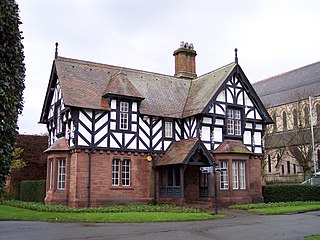
Grosvenor Park is a public park in the city of Chester, Cheshire, England. It consists of 20 acres (8.1 ha) of land overlooking the River Dee. It is regarded as one of the finest and most complete examples of Victorian parks in the North West of England, if not nationally. On 22 August 2013 the designation of the park was raised from Grade II in the National Register of Historic Parks and Gardens to Grade II*.

The Carnegie Library is in Egerton Street, Runcorn, Cheshire, England. It is recorded in the National Heritage List for England as a designated Grade II listed building and "possesses special architectural and historic interest within a national context". It was built in 1906 to replace an earlier library with a grant from Andrew Carnegie, and closed in 2012.

Eccleston Hill Lodge is a gateway and lodge near the village of Eccleston, Cheshire, England. It stands at the entrance of the Chester Approach to the estate of Eaton Hall. The structure is recorded in the National Heritage List for England as a designated Grade II* listed building.

Upper Belgrave Lodge is a house at the east end of Belgrave Avenue, the road connecting the B5445 road between Chester and Wrexham, and Eaton Hall, Cheshire, England. It is recorded in the National Heritage List for England as a designated Grade II listed building.
Cogshall Hall is a country house near the village of Comberbach, Cheshire, England. It was built in about 1830 for Peter Jackson. A kitchen wing was added to the rear during the early 20th century. It is constructed in red-brown brick, and has a slate hipped roof. It is rectangular in plan, and has two storeys. Its architectural style is Georgian. The entrance front has five bays and an Ionic portico. There is a similar, smaller portico on the right side. The house is recorded in the National Heritage List for England as a designated Grade II* listed building. The lodge to the hall was built at about the same time. It has a Tuscan porch with a pediment, and is listed at Grade II. The architectural historian Nikolaus Pevsner refers to the lodge as being "ambitious".
Tattenhall Hall is a country house standing to the south of the village of Tattenhall, Cheshire, England. It was built in the early part of the 17th century, before 1622, for Richard Bostock. The house was bought in 1856 by Robert Barbour who restored the house and commissioned Thomas Harrison to design gate piers and farm buildings. It is constructed in brick with sandstone dressings and a Welsh slate roof, and is an early example of a brick building in Cheshire. The architectural style is Jacobean. It has an irregular H-shaped plan, in two and three storeys, with an entrance front of five bays. It contains two gables that are similar in style, but have difference in heights, suggesting that they were designed separately. The house is designated by English Heritage as a Grade II* listed building. Associated with the hall are two structures listed at Grade II. The sandstone gate piers and wing walls were built probably in 1858 and designed by Thomas Harrison. The haybarn to the southeast of the hall was built in 1858 and was also designed by Harrison.

Whirley Hall is a country house standing to the north of the village of Henbury, Cheshire, England. The house dates from about 1670. Additions and alterations were made during the 18th century and in the 1950s, when the house was restored and wings were added at the sides. The house is constructed in brick with buff sandstone dressings, and has a Kerridge stone-slate roof with stone ridges. It has three storeys and symmetrical five-bay front. Between the storeys, and above the top storey, are brick bands. The lower two storeys contain 20th-century wooden-framed mullioned and transomed windows. In the top storey are two-light casement windows. Above these are two shaped gables, each surmounted by an obelisk finial, and containing an elliptical window. There are single-storey, two-bay extensions on each side of the house. In the roof of the house is a stone inscribed with the date 1599, which is considered to have been removed from an earlier timber-framed house. The house is recorded in the National Heritage List for England as a designated Grade II* listed building. The gate pier in front of the house is a Grade II listed building.

Oakfield Manor was originally a country house in Upton by Chester, near Chester, Cheshire, England. Since the 1930s it has been the headquarters of Chester Zoo. The house and its stables are recorded separately in the National Heritage List for England as designated Grade II listed buildings.

Overleigh Lodge is in Duke's Drive, Chester, Cheshire, England. The lodge, together with its associated gates, gate piers and screens, are recorded in the National Heritage List for England as a designated Grade II listed building. It was built at the entrance of the Chester Approach to Eaton Hall for the 1st Duke of Westminster, and designed by the London architect Robert William Edis. The approach has since been cut by the A55 road. The lower storey of the two-storey lodge is in yellow sandstone; the upper storey is in red brick with blue brick diapering and has a shaped gable. The roofs are in green Westmorland slate. The lodge also has a round turret with a conical spire, and an elaborate central chimney stack.

Abbot's Wood was a large country house and estate located to the north-northeast of Barrow-in-Furness, Cumbria, England. It was sited on elevated ground to the northeast of Furness Abbey. The house was surrounded by extensive grounds with footpaths providing fine views.
Dawpool was a country house in the village of Thurstaston, Wirral, Merseyside, England. It was built for the shipowner Thomas Henry Ismay in 1882–86 and designed by Richard Norman Shaw. Ismay died in 1899, the family moved out of the house in 1907, and it was demolished in 1927. Parts of the house were re-used in other buildings. Two buildings associated with the house, a lodge and the stables, have survived and are listed buildings.






